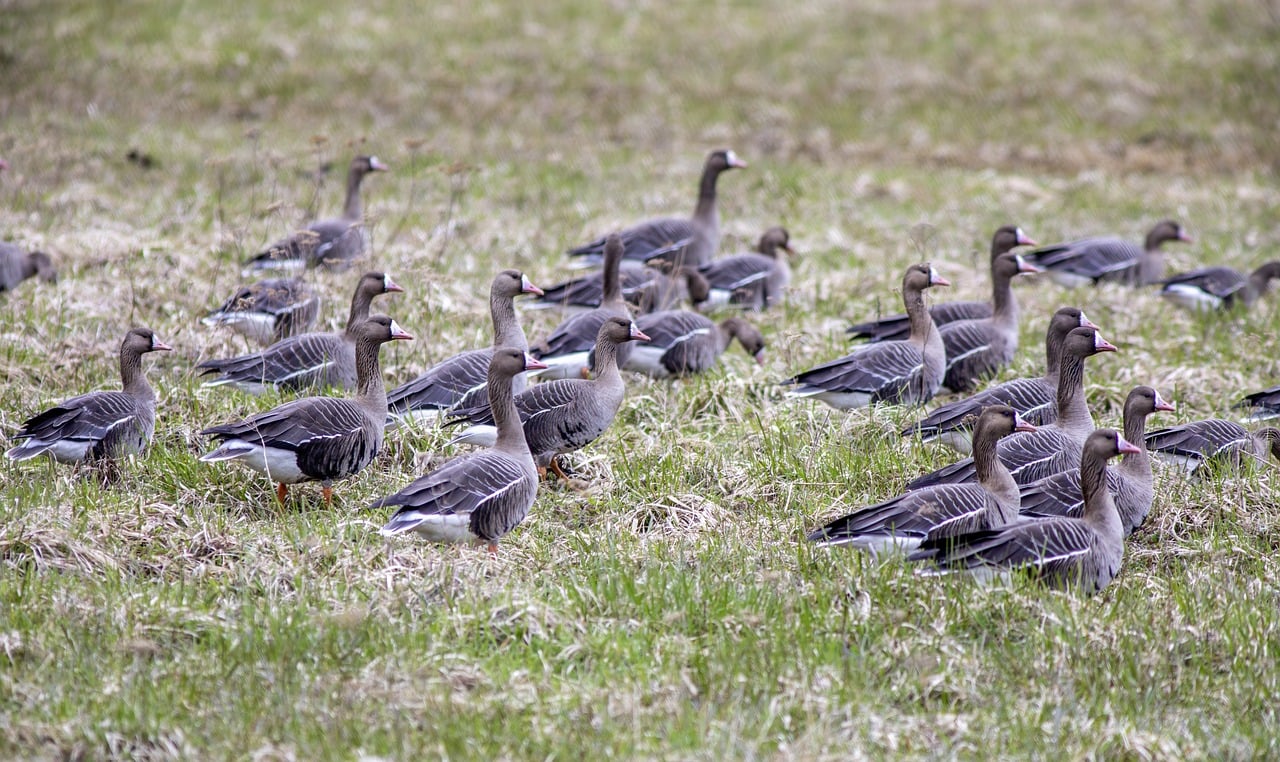The Greater White-fronted Goose (Anser albifrons) is a distinctive and widespread species of goose found in the northern parts of North America, Europe, and Asia. Known for its striking appearance and migratory behavior, it plays an important role in the ecosystems it inhabits.
Physical Description
- Size: The Greater White-fronted Goose is a medium-sized goose, measuring about 60 to 75 cm (24 to 30 inches) in length, with a wingspan of 140 to 170 cm (55 to 67 inches). It typically weighs between 1.5 to 3.5 kg (3.3 to 7.7 lbs).
- Plumage: Adults are recognized by their distinctive white-fronted markings. The most notable feature is the white patch at the base of the bill and the front of the neck, which contrasts with the dark brown and grey body. They also have a blackish-brown belly with vertical white or pale streaks and a darker head.
- Bill and Legs: The bill is orange with a black base, and the legs are also orange.
- Juveniles: Young birds are generally mottled brown and grey, lacking the distinctive white front and often appearing more uniform in color.
Distribution and Habitat
- Breeding Range: The Greater White-fronted Goose breeds in the Arctic and sub-Arctic regions, including northern Canada, Alaska, Greenland, Iceland, Scandinavia, and northern Russia. It prefers open tundra, bogs, and wet meadows for breeding.
- Wintering Range: During the winter months, it migrates to more temperate regions, including the central and southern parts of North America, Europe, and parts of East Asia. Winter habitats include estuaries, wetlands, agricultural fields, and grasslands.
Behavior and Diet
- Diet: The Greater White-fronted Goose is primarily herbivorous. Its diet consists of a variety of plant materials, including grasses, sedges, and seeds. During the winter, it may also feed on agricultural crops such as wheat and barley.
- Feeding Behavior: They are known for their grazing habits and can often be seen in large flocks feeding in fields or wetlands. They use their bills to graze and uproot vegetation.
- Migration: These geese are migratory and undertake long migrations between their breeding and wintering grounds. Migration typically occurs in flocks, and they are known for their distinctive honking calls during flight.
Breeding and Lifespan
- Nesting: Breeding usually starts in late spring to early summer. They build nests on the ground, often in a depression lined with grass and down. The nests are usually located in sheltered areas near water.
- Eggs and Chicks: The female typically lays 4 to 7 eggs, which are incubated for about 24 to 28 days. After hatching, the goslings are precocial, meaning they can walk and swim almost immediately. They are cared for by both parents until they are capable of independent feeding and flying.
- Lifespan: In the wild, Greater White-fronted Geese can live up to 15 years, though many have shorter lifespans due to predation and environmental factors.
Vocalizations and Social Behavior
- Calls: Greater White-fronted Geese are known for their loud, honking calls, which are used for communication between individuals and within flocks. Their vocalizations are especially prominent during flight and when they are in large groups.
- Social Structure: They are social birds and often form large flocks, particularly during migration and wintering periods. These flocks can sometimes number in the thousands.
Conservation Status
The Greater White-fronted Goose is generally considered to be of Least Concern by the IUCN. Populations are stable, although they can be affected by habitat changes, hunting pressures, and climate change. Conservation efforts focus on protecting key breeding and wintering habitats to ensure the continued health of their populations.
Summary
The Greater White-fronted Goose (Anser albifrons) is a striking and adaptable species known for its distinctive white-fronted markings and migratory behavior. It inhabits a range of habitats across its extensive breeding and wintering grounds, playing an important role in the ecosystems it occupies. Its social nature and impressive migrations make it a fascinating subject of study for ornithologists and bird enthusiasts alike.ghtful sight and sound in its native habitats.
Views: 1348
Subscribe to the newsletter:
